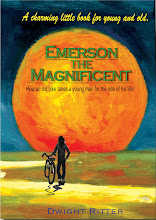JoAnn sets up her painting paraphernalia on a picnic table. She paints oblivious to anyone. . .another silent silhouette. My, how peace attracts man. The Mexicans, the Sioux fisherman, his wife and the Muslims. That’s basically it. Now other cars are showing up, everyone has a fishing rod and collapsible chair. No one is catching fish but there sure are a lot of red, floating strike indicators in the water, wandering as if interested in each other. This planet is called Earth, I think to myself. Humans relaxing while their strike indicators work. We are God. The strike indicators are us.
Here is a related thought:
Washington DC Metro Station on a cold January morning. A man hunkered near the wall with violin and tin can. He played six Bach pieces for about 45 minutes. During that time approximately two thousand (2,000) people went through the station, most of them on their way to work. After four minutes the violinist received his first dollar: a woman threw the money in the tin can and, without stopping, continued to walk.
A few minutes later a young man leaned against the wall to listen to him, then looked at his watch and started to walk again. A three-year-old boy stopped but his mother tugged him along hurriedly. He objected. She insisted. This action was repeated by several other children. Every parent, without exception, forced them to move on.
The violinist continued. After 45 minutes only 6 people had stopped and stayed for a while. About 20 gave him money but continued to walk their normal pace. He collected $32. After an hour, he finished playing and silence took over. No one noticed. No one applauded, nor was there any recognition.
Here is what no one knew:
The violinist was Joshua Bell, one of the best musicians in the world. He played one of the most intricate pieces ever written, with a violin worth $3.5 million dollars. Two days before, Joshua Bell sold out a theater in Boston where the seats averaged $100.
This is a real story.
In a common place environment at an inappropriate hour, do we perceive beauty? Do we stop to appreciate it? Do we recognize talent in an unexpected context? If we do not have a moment to stop and listen to one of the best musicians in the world playing some of the finest music ever written, with one of the most beautiful instruments . . .How many other things are we missing? Do we seek God similarly, ignoring His essence because we focus on the distraction. . . the strike indicators?
Here at Flatiron, only JoAnn Ritter attempts to capture the true reality. It is obvious to her. She does not dwell on details. They are distractions that clutter the beauty of the whole. Impressionists are that way.


